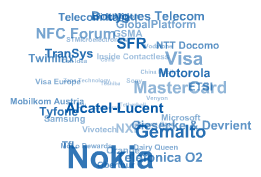
It almost is the end of 2009. And where does near-field proximity communication-based applications stand? From mobile marketing, to customer loyalty, payments and authentication, to information exchange, transportation and health-care. Well, it still stands very far from its full potential.
| Due to its characteristics, proximity is an excellent class of physical interaction. And inherently a very special class of interaction. It can be very personal, in theory secure, and it can be very localized — all excellent attributes for interactions that provide secure context. |
Regardless of its potential and benefits to consumers (which is about convenience) and the real business models that exist, NFC have had major adoption (growing) pains. Pilots have said again and again that consumers do like the convenience, but it is the enablement problem what has basically prevented its adoption. It took Bluetooth more than 10 years and it will take NFC the same.
If we wanted to deliver the convenience benefits of proximity-interactions today, what is the answer? Will it be RFID or NFC the one that stands up at the end? Will it be embedded chip-sets, USB or microSD, or plain RFID stickers?
While not the perfect vision the NFC Forum members had, sticker (RFID) are the short-term solution for this today. Some call it an interim solution, but we will see.
From Blaze Mobile (to whom I provided my services to back when they were called MobileCandyDish), to Giesecke & Devrient, Alcatel-Lucent (my current employer), Oberthur Technologies, MasterCard, First Data, and Tetherball, they all are dealing with the realities of NFC and while waiting for it have decided to follow the “RFID sticker” route. Blaze Mobile was one of the first one years ago.
Stickers. But RFID stickers are very limiting as they are limited to “one function”. How many stickers can you fit, or want to fit, on the back of your phone? Yet stickers bring NFC close to reality. Expect branded and colorful RFID stickers of all kinds.
When I saw ViVOTech (a leader on NFC and contactless in general) recently announce their ViVOtag product; in other words, even ViVOtech has submitted to the realities of NFC, I said to myself, “NFC is dead, long live NFC” – this time is the sticker way. Yuck. See ViVOtech Launches ViVOtag.
There are other vendors going the route of USB or microSD NFC devices such as Tyfone, Giesecke & Devrient and DeviceFidelity. Another example is Sony — see Sony’s next generation Memory Stick which might potentially be integrated with NFC.
In the meantime Gemalto Boosts Rollout of SIM-Based Mobile Contactless Services and touchatag, an Alcatel-Lucent venture and Clear2Pay partner on technology for contactless payments.
And as I wrote before, Will the iPhone trigger the Mobile RFID/NFC revolution?
So there is lots of interest, noise and activity related to mobile NFC/RFID. It is a matter of time, I’m convinced. But the ideal solution is NOT stickers, yet stickers are the fastest and cheaper way to get there, and because of that, the best way to validate the applications and models. And once that happens, I hope that for the sake of the consumers themselves that we move on to a solution that allows for MULTIPLE applications such as smart-cards or handset-based (which includes USB or microSD-based) approaches.
| For a good paper on alternative NFC form factors see white-paper by The Human Chain titled Alternative NFC form factors. |
Now, last but probably the top deployment reason why proximity interactions based on NFC/RFID are extremely important: to work around that pesky patent on barcode interactions (i.e. nn-ee-oo-mm-ee-dd-ii-aa); with the NFC/RFID path there is clear and well documented (including in the NFC standards) prior-art.
It is time for operators and device manufacturers to push for NFC. Yes, enabling NFC require investment but pilots already provided good results. Go sticker in the interim to validate, and remember that it is about the applications and usability. No need to wait on Apple, again, to define the path. (The exception to all this is Nokia who has been forward looking since day one, with the handsets, APIs, documentation and toolkit to make this happen.)
ceo
Pingback: Carnival of the Mobilists #201 — burning the bacon with barrett
Pingback: Carnival of Mobilists #201 at WIP Jam Sessions – Connecting Developers
Pingback: McGuire’s Law » Blog Archive » Enabling Technology: December 23, 2009